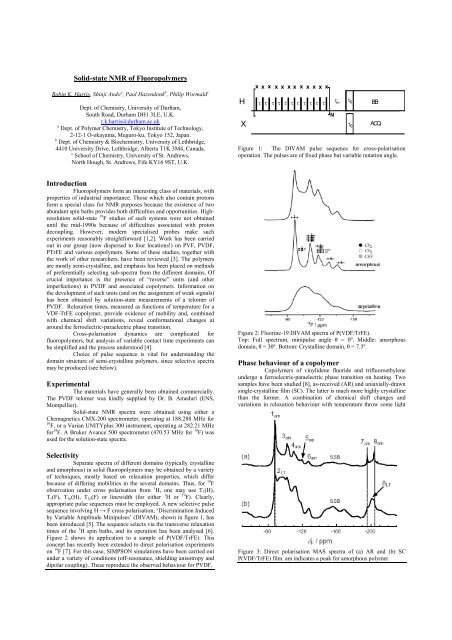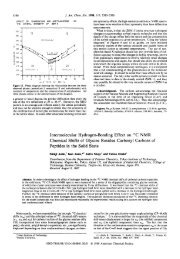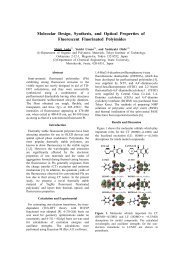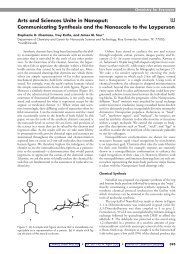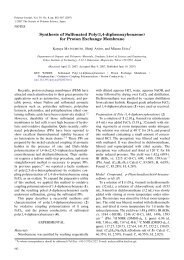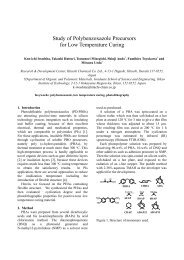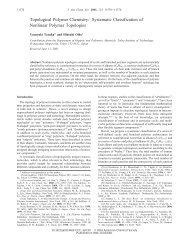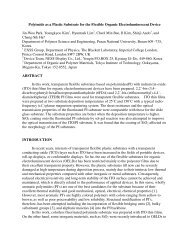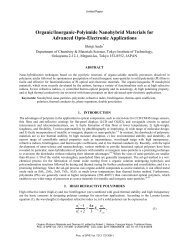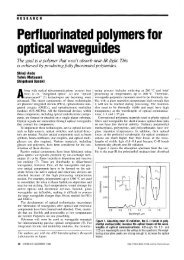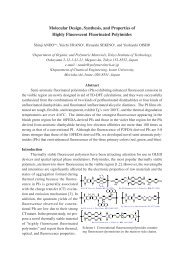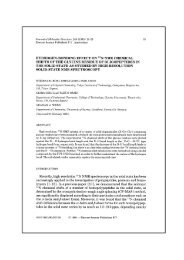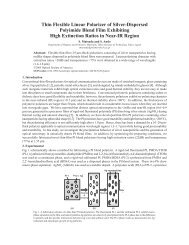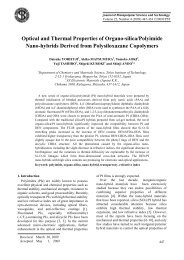Solid-state NMR of Fluoropolymers Introduction Experimental ...
Solid-state NMR of Fluoropolymers Introduction Experimental ...
Solid-state NMR of Fluoropolymers Introduction Experimental ...
You also want an ePaper? Increase the reach of your titles
YUMPU automatically turns print PDFs into web optimized ePapers that Google loves.
<strong>Solid</strong>-<strong>state</strong> <strong>NMR</strong> <strong>of</strong> <strong>Fluoropolymers</strong>Robin K. Harris, Shinji Ando a , Paul Hazendonk b , Philip Wormald cDept. <strong>of</strong> Chemistry, University <strong>of</strong> Durham,South Road, Durham DH1 3LE, U.K.r.k.harris@durham.ac.uka Dept. <strong>of</strong> Polymer Chemistry, Tokyo Institute <strong>of</strong> Technology,2-12-1 O-okayama, Meguro-ku, Tokyo 152, Japan.b Dept. <strong>of</strong> Chemistry & Biochemistry, University <strong>of</strong> Lethbridge,4410 University Drive, Lethbridge, Alberta T1K 3M4, Canada.c School <strong>of</strong> Chemistry, University <strong>of</strong> St. Andrews,North Hough, St. Andrews, Fife KY16 9ST, U.K.HXx x x x x x x x x x x xτ τ τ τ τ τ τ τ τ τ τNτ mτ Cτ CBBACQFigure 1: The DIVAM pulse sequence for cross-polarisationoperation. The pulses are <strong>of</strong> fixed phase but variable nutation angle.<strong>Introduction</strong><strong>Fluoropolymers</strong> form an interesting class <strong>of</strong> materials, withproperties <strong>of</strong> industrial importance. Those which also contain protonsform a special class for <strong>NMR</strong> purposes because the existence <strong>of</strong> twoabundant spin baths provides both difficulties and opportunities. Highresolutionsolid-<strong>state</strong> 19 F studies <strong>of</strong> such systems were not obtaineduntil the mid-1990s because <strong>of</strong> difficulties associated with protondecoupling. However, modern specialised probes make suchexperiments reasonably straightforward [1,2]. Work has been carriedout in our group (now dispersed to four locations!) on PVF, PVDF,PTrFE and various copolymers. Some <strong>of</strong> these studies, together withthe work <strong>of</strong> other researchers, have been reviewed [3]. The polymersare mostly semi-crystalline, and emphasis has been placed on methods<strong>of</strong> preferentially selecting sub-spectra from the different domains. Ofcrucial importance is the presence <strong>of</strong> “reverse” units (and otherimperfections) in PVDF and associated copolymers. Information onthe development <strong>of</strong> such units (and on the assignment <strong>of</strong> weak signals)has been obtained by solution-<strong>state</strong> measurements <strong>of</strong> a telomer <strong>of</strong>PVDF. Relaxation times, measured as functions <strong>of</strong> temperature for aVDF-TrFE copolymer, provide evidence <strong>of</strong> mobility and, combinedwith chemical shift variations, reveal conformational changes ataround the ferroelectric-paraelectric phase transition.Cross-polarisation dynamics are complicated forfluoropolymers, but analysis <strong>of</strong> variable contact time experiments canbe simplified and the process understood [4].Choice <strong>of</strong> pulse sequence is vital for understanding thedomain structure <strong>of</strong> semi-crystalline polymers, since selective spectramay be produced (see below).<strong>Experimental</strong>The materials have generally been obtained commercially.The PVDF telomer was kindly supplied by Dr. B. Ameduri (ENS,Montpellier).<strong>Solid</strong>-<strong>state</strong> <strong>NMR</strong> spectra were obtained using either aChemagnetics CMX-200 spectrometer, operating at 188.288 MHz for19 F, or a Varian UNITYplus 300 instrument, operating at 282.21 MHzfor 19 F. A Bruker Avance 500 spectrometer (470.53 MHz for 19 F) wasused for the solution-<strong>state</strong> spectra.SelectivitySeparate spectra <strong>of</strong> different domains (typically crystallineand amorphous) in solid fluoropolymers may be obtained by a variety<strong>of</strong> techniques, mostly based on relaxation properties, which differbecause <strong>of</strong> differing mobilities in the several domains. Thus, for 19 Fobservation under cross polarisation from 1 H, one may use T 1(H),T 1(F), T 1ρ(H), T 1ρ(F) or linewidth (for either 1 H or 19 F). Clearly,appropriate pulse sequences must be employed. A new selective pulsesequence involving H → F cross polarisation, ‘Discrimination Inducedby Variable Amplitude Minipulses’ (DIVAM), shown in figure 1, hasbeen introduced [5]. The sequence selects via the transverse relaxationtimes <strong>of</strong> the 1 H spin baths, and its operation has been analysed [6].Figure 2 shows its application to a sample <strong>of</strong> P(VDF/TrFE). Thisconcept has recently been extended to direct polarisation experimentson 19 F [7]. For this case, SIMPSON simulations have been carried outunder a variety <strong>of</strong> conditions (<strong>of</strong>f-resonance, shielding anisotropy anddipolar coupling). These reproduce the observed behaviour for PVDF.Figure 2: Fluorine-19 DIVAM spectra <strong>of</strong> P(VDF/TrFE).Top: Full spectrum, minipulse angle θ = 0º. Middle: amorphousdomain, θ = 30º. Bottom: Crystalline domain, θ = 7.3º.Phase behaviour <strong>of</strong> a copolymerCopolymers <strong>of</strong> vinylidene fluoride and trifluoroethyleneundergo a ferroelectric-paraelectric phase transition on heating. Twosamples have been studied [8], as-received (AR) and uniaxially-drawnsingle-crystalline film (SC). The latter is much more highly crystallinethan the former. A combination <strong>of</strong> chemical shift changes andvariations in relaxation behaviour with temperature throw some lightFigure 3: Direct polarisation MAS spectra <strong>of</strong> (a) AR and (b) SCP(VDF/TrFE) film. am indicates a peak for amorphous polymer.
on this process. In particular, whilst some signals show significantshift changes in the range 43 - 92ºC, others do not, revealing thatVDF-TrFE head-to-tail sequences form the most stable part <strong>of</strong> thepolymer chains with respect to trans-gauche conformational exchangemotions below the transition temperature, T c . However, the wholechain undergoes conformational exchange at about T c, which occurs inthe range 118 - 125ºC on heating. The 19 F bandshape changessignificantly in the same temperature range. Also, T 1ρ(F) for thecrystalline material (Table 1) decreases to a common value <strong>of</strong> ca. 20ms at 119ºC, indicating the onset <strong>of</strong> full chain rotation. All themeasurements were subject to a pronounced hysteresis on cooling, thephase transition occurring between 85 and 77ºC.3.65 3.64 3.63 3.62 3.61 3.60 3.59 3.58 3.57 3.56 ppmPeak 1 HT 3 4 5 6 7 HT 8 HTTemperature/ ºCHeatingCooling107 55 114 94 37 48 39 73119 21.6 22.0 20.0 20.2 19.2 21.9 21.385 16.4 20.1 18.9 20.8 12.9 13.9 14.477 28 36 42 54 53 43 33Table 1. T 1ρ(F) data for P(VDF/TrFE) SC film.Note: This table is incorrectly formatted in ref. [8].Imperfections in PVDFHead-to-head (-CF 2CF 2-) and tail-to-tail(-CH 2CH 2-) units are commonly to be found in PVDF, and theirconcentration can pr<strong>of</strong>oundly affect the physical properties <strong>of</strong> thepolymer. Weak RFDR cross-peaks [9] suggest that, although thesereverse units occur primarily in amorphous domains, some are foundin relatively rigid environments, probably at the interface <strong>of</strong>amorphous and crystalline domains. However, weak signals for otherimperfections and/or impurities can also be observed in 19 F spectra.For instance, a highly mobile site gives rise to a resonance atδ F = – 115 ppm. This has been attributed to –CH 2CF 2H end groups. Inorder to understand better the occurrence <strong>of</strong> such signals, we haveexamined [10] solution-<strong>state</strong> 1 H and 19 F spectra <strong>of</strong> a telomer <strong>of</strong> PVDF<strong>of</strong> average molecular mass ca. 2000. Many weak signals can beobserved. Part <strong>of</strong> the proton spectrum in the region <strong>of</strong> δ H = 3.6 ppm isshown in figure 4. The band consists <strong>of</strong> a triplet <strong>of</strong> doublets, whichreduces to a simple doublet when fluorine-decoupled (and hencebelongs to a –CH 2CH 2CF 2- group), plus two triplets which areunaffected by fluorine decoupling (and therefore are assigned to–CH 2 CH 2 X- protons, where X presumably has no protons or fluorinesattached). Assignments <strong>of</strong> the entire 1 H and 19 F spectra may be madeusing the coupling patterns, together with COSY, TOCSY andHETCOR experiments. The results reveal the existence <strong>of</strong> both endgroups and small molecules, present as a result <strong>of</strong> the synthesisprocedure.3.65 3.64 3.63 3.62 3.61 3.60 3.59 3.58 3.57 3.56 ppmFigure 4. Parts <strong>of</strong> the proton spectra <strong>of</strong> a VDF telomer. Above:Fluorine-coupled. Below: Fluorine-decoupled.Conclusions<strong>NMR</strong> experiments, both for solid samples and solutions,reveal a wealth <strong>of</strong> detail about the chemical nature (includingconformations), domain structure, imperfections and mobility <strong>of</strong>fluoropolymers.AcknowledgementsWe thank Drs. P. Avalle and D.C. Apperley for theirassistance.References[1] Carss, S.A.; Harris, R.K.; Holstein, P.; Say, B.J.; Fletton, R.A. J.Chem. Soc., Chem. Comm. 1994, 2407.[2] Harris, R.K.; Carss, S.A.; Chambers, R.D.; Holstein, P.; Minoja,A.P.; Scheler. A. Bull. Magn. Reson. 1995, 17, 37.[3] Harris, R.K.; Monti, G.A.; Holstein, P., Ch. 18 in ‘<strong>Solid</strong> State<strong>NMR</strong> <strong>of</strong> Polymers’, Eds. Ando, I., Asakura, T., Elsevier ScienceB.V. 1994.[4] Ando, S.; Harris, R.K.; Reinsberg, S.A. J. Magn. Reson. 1999,141, 91.[5] Ando, S.; Harris, R.K.; Holstein, P.; Reinsberg, S.A.; Yamauchi,K. Polymer 2001, 42, 8137.[6] Hazendonk, P.; Harris, R.K.; Ando, S.; Avalle, P. J. Magn.Reson. 2003, 162, 206.[7] Hazendonk, P., to be published.[8] Aimi, K.; Ando, S.; Avalle, P.; Harris, R.K. Polymer 2004, 45,228.[9] Wormald, P.; Apperley, D.C.; Beaume, F.; Harris, R.K.Polymer, 2003, 44, 643.[10] Wormald, P., Ph. D. Thesis, University <strong>of</strong> Durham, to bepresented 2004.


